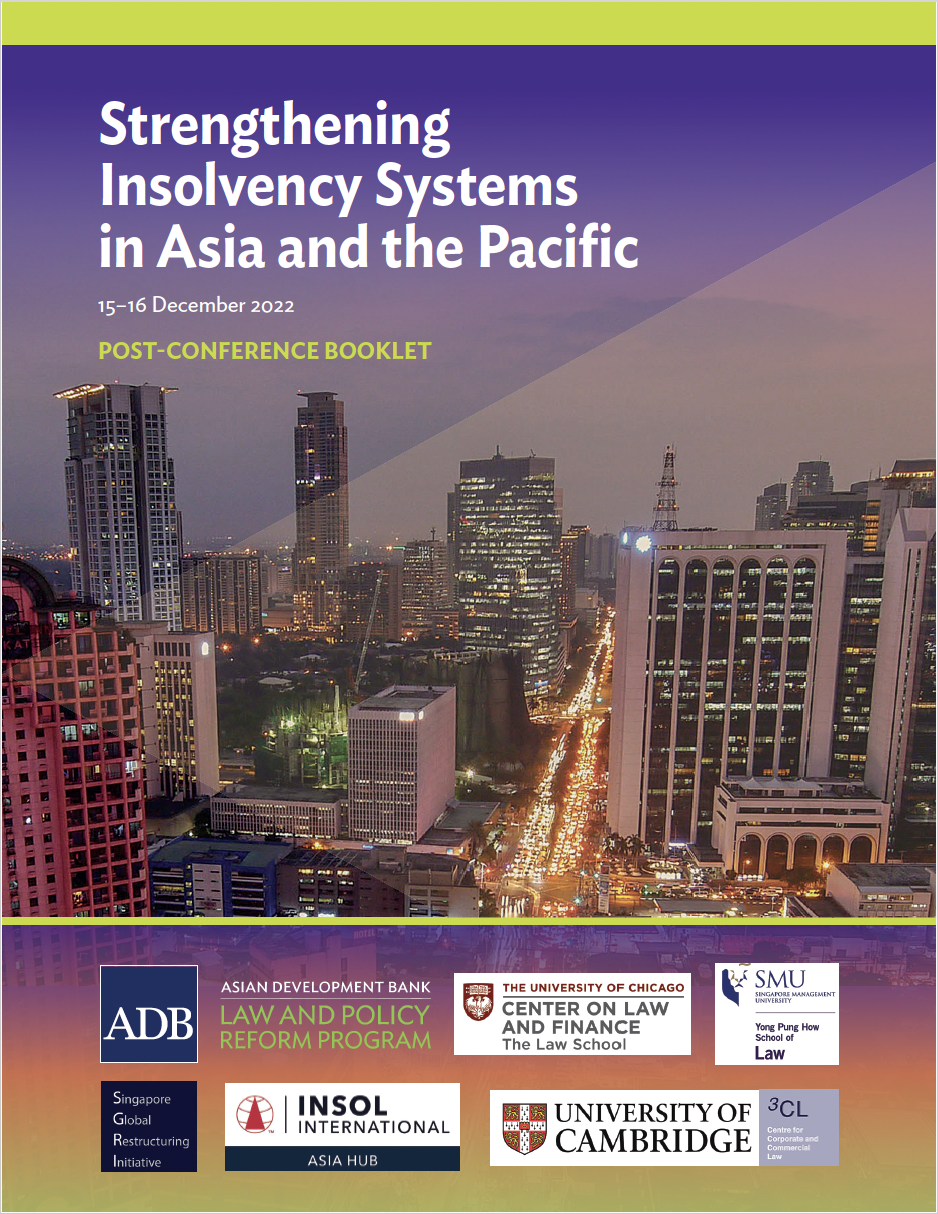Strengthening Insolvency Systems in Asia and the Pacific
An efficient insolvency system is crucial for promoting competitiveness and growth in an economy. Without an effective legal, market and institutional framework to address financial distress, entrepreneurship, access to finance and economic growth may be impeded. Despite its significance, many countries in Asia and the Pacific still have inadequate insolvency frameworks. The conference aimed to address relevant issues in insolvency law, with the goal of encouraging meaningful law reform on the subject.
The conference brought together insolvency law reform experts from around the world, including judges, regulators, academics and lawyers, to discuss ways of enhancing restructuring and insolvency frameworks in Asia and the Pacific. The participants analyzed various aspects and actors involved in insolvency and restructuring proceedings. They formulated strategies to promote a well-functioning insolvency system and discussed important issues related to insolvency law, such as informal workouts, micro and small enterprises, corporate groups, and cross-border insolvency.
Opening Address
Affiliation and position indicated are as of conference date (15-16 December 2022).

Thomas M. Clark
General Counsel, Asian Development Bank
Mr. Thomas M. Clark emphasized the importance of insolvency law reform, especially after the COVID-19 pandemic highlighted the vulnerability of the corporate sector. A well-functioning, credible insolvency system assures stakeholders that, in the event of financial difficulties, companies will be given a reasonable opportunity to restructure in a manner that is fair and protects the interests of creditors. Mr. Clark hoped that the conference would assist delegates in navigating potential reforms on this issue.
Panel 1. Strategies to Effectively Promote Workouts
Affiliations and positions indicated are as of conference date (15-16 December 2022).
The panel discussed the advantages of out-of-court restructuring, also referred to as "workout." These benefits include flexibility, confidentiality and avoidance of the costs and stigma associated with insolvency proceedings. The discussion also covered effective strategies for promoting workouts, as well as country-specific and firm-specific factors that may impact the design and effectiveness of these strategies.

Chairperson: Nicholas Moller
Principal Counsel, Asian Development Bank

Scott Atkins
President, INSOL International; Global Co-Head of Restructuring, Norton Rose Fulbright
Mr. Scott Atkins discussed his experience with insolvency law reform and emphasized the importance of including informal workout mechanisms in these initiatives. He stressed the significance of engaging with stakeholders to build trust and confidence in the process, even before delving into the substantive content of the law. Additionally, Mr. Atkins expressed optimism about the global sweep of insolvency law reform processes.

Adam Badawi
Professor of Law, University of California, Berkeley
Prof. Adam Badawi discussed changes in the United States model for corporate lending and how they have affected the workout process. In the early 2000s, corporate lending involved syndicated loans with a small consortium of banks that had experience working with each other and with debtors experiencing financial distress. Currently, there are more collateralized loan obligations where multiple parties are involved in signing off on issues, making the workout process more challenging.

Antonia Menezes
Senior Financial Sector Specialist, World Bank
Ms. Antonia Menezes explained the different workout models and how The World Bank Toolkit on Corporate Workouts conceptualized these tools. She emphasized that workout frameworks could take various forms and be designed to suit a jurisdiction's specific needs and financial and economic climate.

Stephanie Yeo
Partner, WongPartnership
Ms. Stephanie Yeo discussed insolvency law reform in Singapore and the role of informal workouts. She noted that many businesses in Asia are family-owned, which, along with the absence of cram down legislation, encourages negotiations with the family to facilitate out-of-court workouts.
Panel 2. Hybrid Procedures and Formal Insolvency Proceedings
Affiliations and positions indicated are as of conference date (15-16 December 2022).
The panel discussed various insolvency processes from around the world and evaluated the ideal way to design an insolvency and restructuring framework. They emphasized the importance of considering a country's market and institutional environment when selecting the appropriate procedures.

Chairperson: Aurelio Gurrea-Martinez
Associate Professor of Law and Head of the Singapore Global Restructuring Initiative, Singapore Management University

Scott Atkins
President, INSOL International; Global Co-Head of Restructuring, Norton Rose Fulbright
Mr. Scott Atkins described the effort to introduce insolvency law reform in Australia. However, certain initiatives, such as innovations regarding cross-class cram down and moratorium, have been deferred for now. If these initiatives are passed, they could be an important addition to the country's overall toolkit.

Anthony Casey
Deputy Dean and Donald Ephraim Professor of Law and Economics, The University of Chicago Law School
Prof. Anthony Casey discussed the benefits of hybrid procedures, which enable out-of-court restructurings to commence and receive court approval. He also addressed pre-packaged bankruptcies in the United States, noting their suitability for financial restructuring before filing and without court intervention in business operations.

Edmund Ma
Senior Associate, Baker McKenzie
Mr. Edmund Ma explained why Hong Kong has not yet adopted a formal reorganization procedure. He cited three reasons: (a) potential amendments to the Corporate Rescue Bill are substantial and complicated, (b) the current legislative agenda prioritizes matters of constitutional significance, and (c) initiatives that potentially affect creditor interests generate controversy, especially given Hong Kong's history as a creditor-friendly jurisdiction.

Yu-Wen TAN
Director, Insolvency Division of Insolvency and Public Trustee’s Office, Singapore
Ms. Yu-Wen TAN discussed the recent changes made to Singapore's insolvency law framework. These reforms include enhancements to the scheme of arrangement framework, moratorium, cross-class cram down, super priority for rescue financing, prohibition of ipso facto clauses and the pre-pack scheme of arrangement. These changes aim to improve the country's corporate rescue and restructuring laws and strengthen its position as a forum of choice for debt restructuring.

Mahesh Uttamchandani
Manager for Digital Development in East Asia and the Pacific, World Bank
Mr. Mahesh Uttamchandani emphasized that there is no one-size-fits-all approach to designing formal insolvency proceedings and choosing between single- or multi-entry systems. Instead, he highlighted the significance of the quality of insolvency administrators and the judges presiding over insolvency cases.
Panel 3. Governance of Insolvency and Restructuring Procedures: Debtor in Possession, Insolvency Practitioner, or Hybrid Model?
Affiliations and positions indicated are as of conference date (15-16 December 2022).
The panel discussed the three (3) primary models for governing insolvency and restructuring proceedings: (i) the debtor in possession (DIP) model, (ii) appointment of insolvency practitioners (IP) model, and (iii) the hybrid model. The speakers addressed the legal, market and institutional factors that affect a jurisdiction's selection of a governance model.

Chairperson: Adriana Robertson
Donald N. Pritzker Professor of Business Law, The University of Chicago Law School

Jared Ellias
Professor of Law, Harvard Law School
Prof. Jared Ellias described the evolution of corporate bankruptcy over the years and provided insights into the debtor-in-possession (DIP) framework. He highlighted the lack of clarity regarding the DIP's obligation to serve either creditors or shareholders.

Kotaro Fuji
Counsel, Nishimura & Asahi
Mr. Kotaro Fuji discussed two types of formal insolvency proceedings for restructuring companies in Japan: civil rehabilitation proceedings and corporate reorganization proceedings. According to Mr. Fuji, civil rehabilitation has become increasingly popular in Japan due to its efficient DIP aspect in quickly restructuring a debtor company's business and preserving its going concern value.

Aurelio Gurrea-Martinez
Associate Professor of Law and Head of the Singapore Global Restructuring Initiative, Singapore Management University
Prof. Aurelio Gurrea-Martinez identified country- and firm-specific factors that can affect the optimal governance model of insolvency and restructuring procedures. These factors include the level of expertise of IP in a jurisdiction, as well as the corporate ownership structure prevalent in a country.

Wai Yee WAN
Associate Dean (Research and Internationalization) and Professor, School of Law, City University of Hong Kong
Prof. Wai Yee WAN discussed the insolvency regimes in Hong Kong, India, the People’s Republic of China (PRC) and Singapore. Hong Kong, PRC and India follow the IP model, while Singapore has adopted the DIP model, which is uncommon in Asia.
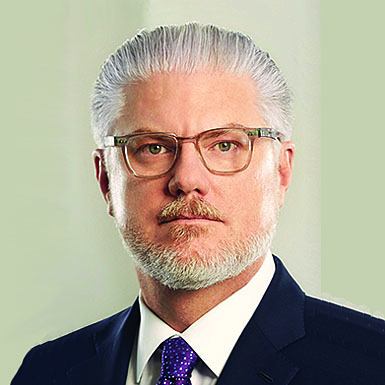
Paul Zumbro
Partner, Cravath, Swaine & Moore LLP
Mr. Paul Zumbro explained the advantages and disadvantages of the DIP model. In the United States, restructurings are preferred over liquidations whenever possible, which is the foundation of the DIP model. This model is based on the belief that existing management is better equipped to maintain continuity not only with creditors but also with employees, vendors, government regulators and other stakeholders. The DIP model may not be appropriate for other jurisdictions that lack transparency and a well-functioning judiciary to oversee it.
Panel 4. Regulatory Framework on Insolvency Practitioners
Affiliations and positions indicated are as of conference date (15-16 December 2022).
The panel discussed the optimal approach to establishing a regulatory framework for IPs, including their qualifications and remuneration. The panelists considered whether jurisdictions should implement government regulation of insolvency practitioners or permit the profession to self-regulate.

Chairperson: John Martin
Partner, Norton Rose Fulbright; President, International Insolvency Institute

Ravi Mital
Chairperson, Insolvency and Bankruptcy Board of India (IBBI)
Mr. Ravi Mital spoke of India's preference for the self-regulatory model. He also outlined the necessary qualifications, appointment process and remuneration of IPs.

Dr. Catherine Robinson
Senior Lecturer, Faculty of Law, University of Technology Sydney, Australia
Dr. Catherine Robinson noted that empirical research indicates inconsistencies among Australia's industry bodies with respect to regulatory approaches to IPs. While one large industry body may oppose regulation, another may strongly support it. Dr. Robinson stated that while the liquidator's/trustee's work involves the reality of a lack of funds to pay, the profession's ultimate objective is not solely to realize a return to creditors. Instead, practitioners value their service's role to the community and prioritize vulnerable debtors.
Panel 5. Valuation of Assets and Treatment of Claims and Contracts in Insolvency Proceedings
Affiliations and positions indicated are as of conference date (15-16 December 2022).
The panel emphasized the significance of valuation in deciding the future of a financially distressed company. They analyzed the best approach to determine the valuation and treatment of assets and claims in insolvency proceedings. The discussion also addressed the treatment of contracts in insolvency, with a particular focus on executory contracts and ipso facto clauses.

Chairperson: Anthony Casey
Deputy Dean and Donald Ephraim Professor of Law and Economics, The University of Chicago Law School

David Chew
Partner, DHC Capital
Mr. David Chew described four (4) primary valuation methods used in insolvency proceedings: discounted cash flow (DCF), relative valuation, asset-based valuation and liquidation value. He explained the principal features of each method. According to Mr. Chew, valuation helps determine several issues, such as (i) which creditors are positioned to be the key stakeholders in restructuring, (ii) the theoretical price of the business, or (iii) the theoretical value of the assets.

Elizabeth McColm
Partner, Paul, Weiss, Rifkind, Wharton & Garrison LLP
Ms. Elizabeth McColm stressed the importance of valuation and transparency in insolvency proceedings. She believes that all parties should have equal access to information, including valuations, and the ability to test them in court through cross-examination.

Debanshu Mukherjee
Co-Founder, Vidhi Centre for Legal Policy, India
Mr. Debanshu Mukherjee explained the role of valuation in India's insolvency proceedings. According to India’s Insolvency and Bankruptcy Code (IBC), stakeholders primarily determine the valuation based on disclosed information before the bidding process. Although there are no formal requirements for the valuation used to approve the plan, formal requirements exist for determining the liquidation value, which is crucial for dissenting and non-voting creditors.

Deepak Rao
General Manager, Insolvency and Bankruptcy Board of India (IBBI)
Mr. Deepak Rao shared his perspective as a regulator on the development of valuation provisions in India. He noted that jurisprudence is still evolving due to the relatively new IBC. Mr. Rao emphasized that a new regulatory regime requires everyone to learn.

Wataru Tanaka
Professor, Institute of Social Science, The University of Tokyo
Prof. Wataru Tanaka discussed the importance of the priority rule set forth in insolvency law. However, he also emphasized the need, in insolvency proceedings, to protect the priority rule specified by the legal regime outside of bankruptcy. Failure to do so may incentivize some rightsholders to use insolvency proceedings to receive preferential treatment, which would only transfer income from other rightsholders and would not increase society's overall benefits.
Panel 6. Directors’ Duties and Liability in the Zone of Insolvency
Affiliations and positions indicated are as of conference date (15-16 December 2022).
This panel analyzed the different types of behavior by directors that could harm creditors and reduce value. It also discussed the approaches taken by different jurisdictions to mitigate such behavior and the various mechanisms for addressing misconduct in the zone of insolvency.

Chairperson: Felix Steffek
Associate Professor, Faculty of Law of the University of Cambridge

Jared Ellias
Professor of Law, Harvard Law School
Prof. Jared Ellias identified several incentives that could lead directors to make suboptimal decisions. These include the incentive to gamble, delay restructuring, facilitate tunneling and act on their own self-interest once a company files for bankruptcy. According to Prof. Ellias, the challenge is determining whether a director's decision is motivated by a bad strategy or if they are simply making what they believe is the right decision for the firm.

Aurelio Gurrea-Martinez
Associate Professor of Law and Head of the Singapore Global Restructuring Initiative, Singapore Management University
Prof. Gurrea-Martinez discussed the approaches of various jurisdictions regarding directors' duties during financial distress. Some jurisdictions allow directors to act in the best interest of the corporation, while others limit a company's ability to incur debts if the directors believe they cannot be paid in full. In some jurisdictions, the most stringent approach prohibits a company from obtaining additional loans when it experiences financial distress.

Jason Harris
Professor of Corporate Law, University of Sydney Law School
Prof. Jason Harris emphasized the importance of differentiating between the general duties of directors and their application during financial distress and formal insolvency, and the specific duties, prohibitions, and, in some cases, crimes that apply to directors leading up to insolvency or informal insolvency. He also stated that including in the legal toolkit criminal offenses or quasi-criminal sanctions to punish directors often defeats the commercial objective of the insolvency and restructuring procedure.

Neeti Shikha
Lecturer, University of Bradford School of Law; Member, Academic Steering Committee INSOL International; Chair, Insolvency Scholar Forum, Insolvency Law Academy
Prof. Neeti Shikha discussed commercial and institutional patterns to consider when dealing with directors’ duties. This includes the issue of multiple directorships, which can lead to poor decision-making. She emphasized that directors should have access to all necessary information. Replacing a director without sufficient information can likewise be problematic.

Paul Zumbro
Partner, Cravath, Swaine & Moore LLP
Mr. Paul Zumbro emphasized the importance of a system that does not impose overly restrictive requirements on directors during insolvency. It is not in anyone's interest for the company's managers to flee at the first sign of distress. Mr. Zumbro suggested incentivizing directors to exercise sound business judgment to maximize the value of the enterprise as a whole.
Panel 7. Avoidance Actions
Affiliations and positions indicated are as of conference date (15-16 December 2022).
The panel discussed avoidance actions, i.e., adversary actions, that aim to avoid transactions made by a debtor before insolvency proceedings. The panelists noted that avoidance provisions can create uncertainty in business and impact legal predictability in a jurisdiction. To address both issues, the panel considered how to design avoidance provisions that take into account conflicting policy objectives and the specific characteristics of a country.

Chairperson: Jared Ellias
Professor of Law, Harvard Law School

Sumant Batra
President, Insolvency Law Academy
Mr. Sumant Batra highlighted the progress made on the IBC in India. However, he noted that there has been little progress on the issue of avoidance action, resulting in a backlog of applications in courts. Fortunately, the Indian market is mature and understands the importance of avoidance transactions. Mr. Batra is optimistic that India will pay more attention to pending avoidance transactions and unlock significant amounts of money locked in those proceedings.

Charles D. Booth
Michael J. Marks Distinguished Professor in Business Law; Director, Institute of Asian-Pacific Business Law (IAPBL), William S. Richardson School of Law, University of Hawai‘i at Manoa
Prof. Charles D. Booth discussed the challenges of designing avoidance action laws in developing economies. He noted that the complexity of the issue makes it difficult to implement in economies that have not previously considered avoidance actions. Additionally, policymakers often do not prioritize avoidance powers when working on law reform.

Brook Gotberg
Francis R. Kirkham Professor of Law, Brigham Young University
Prof. Brook Gotberg discussed the order of avoidance actions from most to least intuitive. According to her, the most intuitive clawback is an intentionally fraudulent conveyance where the debtor gives away money to defraud creditors or where an insider transfers money away from the company. The next level of intuitive clawback is the constructive fraudulent transfer, followed by setoff preferences and insider preference. Lastly, the least intuitive transfer is the general preference law.

Joshua Macey
Assistant Professor of Law, The University of Chicago Law School
Prof. Joshua Macey made three (3) main points about avoidance law. Firstly, there are actual fraudulent transfers where property is transferred with the intent to defraud, hinder or delay creditors. Secondly, constructive fraud occurs when the debtor receives less than equivalent value in exchange for the transfer, and was either insolvent at the time, or rendered insolvent by the transfer, or left with unreasonably small capital. Third, there are voidable preferences where a trustee can recover a payment made within 90 days of the filing date if the transfer was made for the benefit of a creditor on account of an antecedent debt incurred when the debtor was insolvent.
Panel 8. Insolvency Frameworks for Individuals and Micro and Small Enterprises
Affiliations and positions indicated are as of conference date (15-16 December 2022).
The panel highlighted the importance of micro and small enterprises (MSEs) and the need to adopt a more attractive insolvency framework for small businesses. The panel also stressed that policy recommendations should be adapted to diverse market and institutional environments.

Chairperson: Nicholas Moller
Principal Counsel, Asian Development Bank

Charles D. Booth
Michael J. Marks Distinguished Professor in Business Law; Director, Institute of Asian-Pacific Business Law (IAPBL), William S. Richardson School of Law, University of Hawai‘i at Manoa
Prof. Charles D. Booth shared his experience in law reform in the Asia Pacific region in the context of insolvency law reform for MSEs. He highlighted the issue of bankruptcy stigma but noted that effective bankruptcy laws could help overcome it. Prof. Booth also stressed the importance of training insolvency administrators and judges to assist financially distressed MSEs.

Jason Harris
Professor of Corporate Law, University of Sydney Law School
Prof. Jason Harris emphasized the importance of policymakers considering economic reality and the personal circumstances of MSE owner-managers. He suggested that MSEs should seek advice as early as possible, particularly when the company is in the early stages of decline. As an example, he cited Australia, where small businesses frequently avoid the insolvency system altogether due to concerns about losing their family homes or not having enough funds to hire insolvency practitioners.

John Martin
Partner, Norton Rose Fulbright; President, International Insolvency Institute
Mr. John Martin shared his experience in law reform projects across Asia, specifically in jurisdictions with existing insolvency laws that require improvement, as well as those with little or no tradition in insolvency. He explained how policymakers overcame challenges in both scenarios with the aid of various international organizations, particularly those with expertise in MSEs. He emphasized the importance of insolvency laws that address the specific needs of the MSE sector.

Sergio Muro
Financial Sector Specialist, World Bank
Mr. Sergio Muro discussed the Principles for Effective Insolvency and Creditor-Debtor Regimes (the Principles) developed by the World Bank in 2001, as well as their 2021 revised version. The Principles aim to simplify insolvency processes for MSEs and ensure the discharge of debts at the end of the process for natural person entrepreneurs. Mr. Muro underscored the importance of considering MSEs, which represent 95% of all enterprises worldwide.
Panel 9. Rescue Financing and Administrative Expenses
Affiliations and positions indicated are as of conference date (15-16 December 2022).
The panel discussed the impact of insufficient financing on financially distressed companies and the importance of providing post-petition financing for viable but insolvent companies. They also examined changes in rescue financing in some jurisdictions and how these changes have affected the way debtors and creditors approach the issue.

Chairperson: Richard Squire
Alpin J. Cameron Chair in Law, Fordham University School of Law

Jared Ellias
Professor of Law, Harvard Law School
Prof. Jared Ellias discussed that DIP financing used to involve large loans that were typically payable in two to three years. Nowadays, they often come with strict covenants that require reorganization within a certain timeframe, often ranging from 45 days to nine months. Prof. Ellias believes that while DIP loans truly serve as rescue financing in some cases, they are now often used for other purposes, such as securing control.

Aurelio Gurrea-Martinez
Associate Professor of Law and Head of the Singapore Global Restructuring Initiative, Singapore Management University
Prof. Aurelio Gurrea-Martinez discussed the types of priority that can be provided to DIP lenders. He also discussed the advantages and disadvantages of allowing creditors to veto new financing obtained by companies in insolvency proceedings.

Justice Christopher Sontchi
International Judge, Singapore International Commercial Court
Justice Christopher Sontchi described his experience with bench DIP financing against the backdrop of the 2008 Asian Financial Crisis, when financing became scarce and the market illiquid. He observed that debtors ultimately obtain a new loan to demonstrate to trade vendors that the company has sufficient liquidity to receive trade terms again.

Paul Zumbro
Partner, Cravath, Swaine & Moore LLP
Mr. Paul Zumbro emphasized the importance of DIP loans in facilitating the restructuring process and preventing parties from lingering in bankruptcy. In certain situations, creditors may be aggressive in controlling the debtor, but judges and creditor committees can effectively counteract such actions.
Panel 10. Corporate Groups
Affiliations and positions indicated are as of conference date (15-16 December 2022).
This panel described how insolvency systems treat corporate groups. Some jurisdictions treat individual companies separately. Other jurisdictions have taken steps to facilitate coordination of insolvency proceedings affecting corporate groups (“procedural coordination”). Finally, other jurisdictions allow the consolidation of assets and liabilities of entities belonging to the same corporate group (“substantive consolidation”).

Chairperson: Felix Steffek
Associate Professor, Faculty of Law of the University of Cambridge
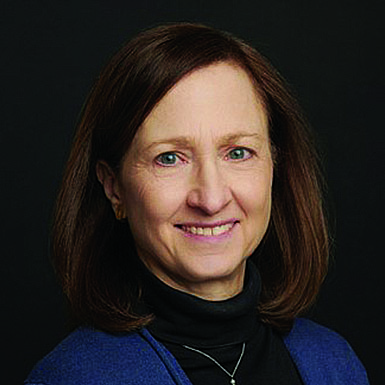
Edith Hotchkiss
Professor of Finance, Carroll School of Management, Boston College
Prof. Edith Hotchkiss discussed the inherent issues that insolvency systems often face, which are compounded when dealing with corporate group structures. These issues include bad faith asset shifting within the group and contagion issues, such as supply chain problems or loss of control over assets in other locations.

Timothy Graulich
Partner, Davis Polk & Wardwell LLP
Mr. Timothy Graulich discussed how failing to consider the corporate group dimension could lead to more liquidations and complicated in-court restructurings. He also explained why corporate groups often choose to file for insolvency proceedings in courts in the United States.
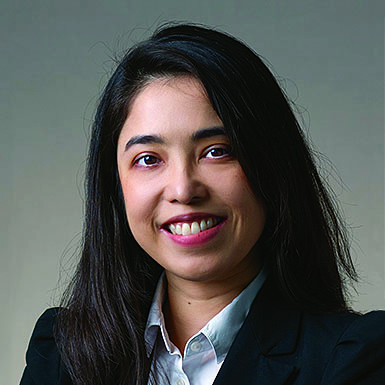
Raelene Pereira
Partner, Rajah & Tann Singapore LLP
Ms. Raelene Pereira discussed Singapore's restructuring and insolvency system as it pertains to corporate groups. She provided specific examples of how cases are administered based on the unique circumstances of each group. Ms. Pereira also highlighted the importance of considering the individual needs of each corporate group.

Richard Squire
Alpin J. Cameron Chair in Law, Fordham University School of Law
Prof. Richard Squire discussed strategies for dealing with financially distressed corporate groups and the boundaries between corporations. He addressed whether these boundaries should be considered solid or if they could be partially or fully collapsed. Additionally, he discussed how debtors should handle these boundaries, including whether managers could put one corporation into bankruptcy while leaving others untouched. Finally, he discussed how legal systems deal with requiring solvent entities to join bankruptcy proceedings of insolvent companies within the same corporate group.
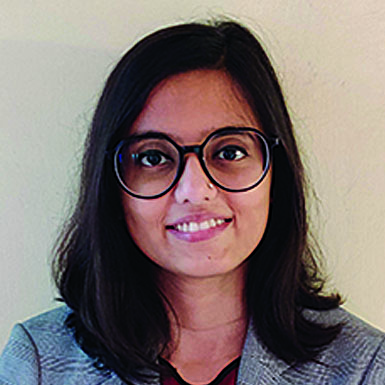
Urmika Tripathi
Legal Analyst for Asia, REDD Intelligence
Ms. Urmika Tripathi explained the framework of the UNCITRAL Model Law for managing corporate groups. The Model Law is based on principles of procedural coordination and does not involve substantive consolidation. According to Ms. Tripathi, the Model Law provides guidelines for coordinating between courts, insolvency practitioners, or group insolvency representatives. The Model Law also respects the jurisdiction of courts that may be handling the insolvency proceedings of other members.
Panel 11. Cross-Border Insolvency
Affiliations and positions indicated are as of conference date (15-16 December 2022).
The panel discussed three different approaches to cross-border insolvency: (i) promoting a single forum for the administration of insolvency proceedings (universalism), (ii) opening insolvency proceedings in jurisdictions where the debtor has assets and creditors (territorialism), and (iii) a mixture of territorialism and universalism (modified universalism). They also discussed new trends and developments in cross-border insolvency.

Chairperson: Justice Christopher Sontchi
International Judge, Singapore International Commercial Court

Joshua Macey
Assistant Professor of Law, The University of Chicago Law School
Prof. Joshua Macey discussed the benefits of using ex ante voting rules to determine the selection of the insolvency forum ex post. He explained that there are compelling reasons for selecting a specific jurisdiction for filing, and these reasons may also apply to cross-border insolvency. Furthermore, cross-border cases present unique challenges.
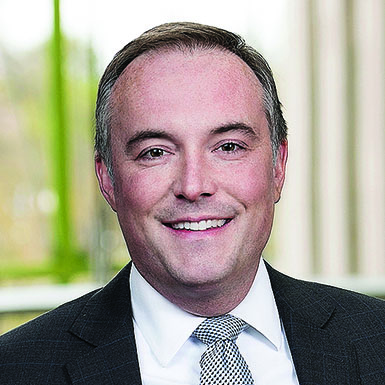
Dan T. Moss
Partner, Jones Day
Mr. Dan T. Moss explained that foreign companies prefer to file for bankruptcy in the United States because of the country's robust legal system and established precedent on the issues. However, this trend has expanded beyond the United States due to the increasingly global and competitive market.

Felix Steffek
Associate Professor, Faculty of Law of the University of Cambridge
Prof. Felix Steffek discussed the differences between universalism, territorialism and modified universalism in cross-border insolvency. He presented the advantages and disadvantages of each system. Additionally, Prof. Steffek explored the reasons why only a few European Union countries have adopted the UNCITRAL Model Law on cross-border insolvency.

Deeptanshu Singh
Manager, Insolvency and Bankruptcy Board of India (IBBI)
Mr. Deeptanshu Singh discussed the progress made in India with regard to cross-border insolvency. He also mentioned the potential adoption of the UNCITRAL Model Law. Finally, he provided examples of how cross-border insolvency cases have been handled in India.
